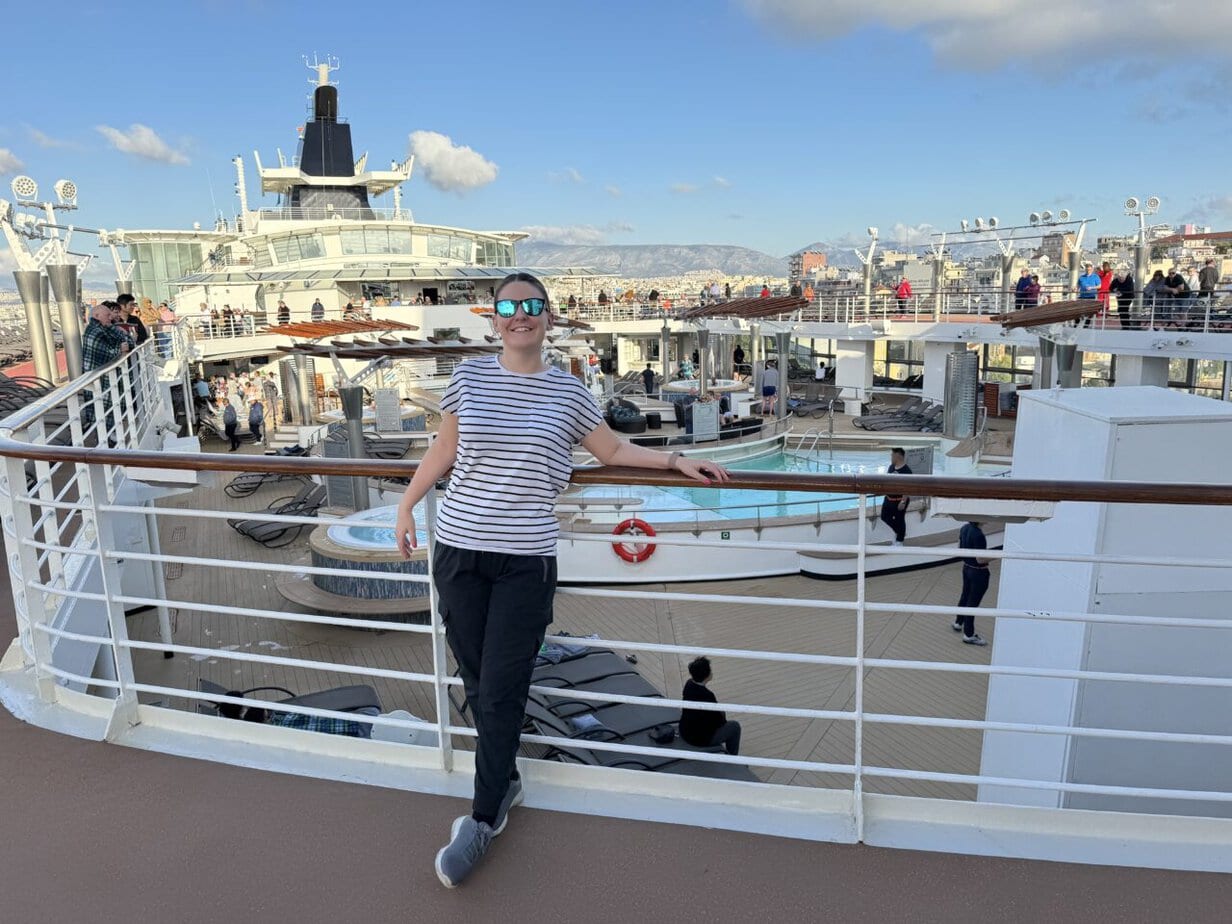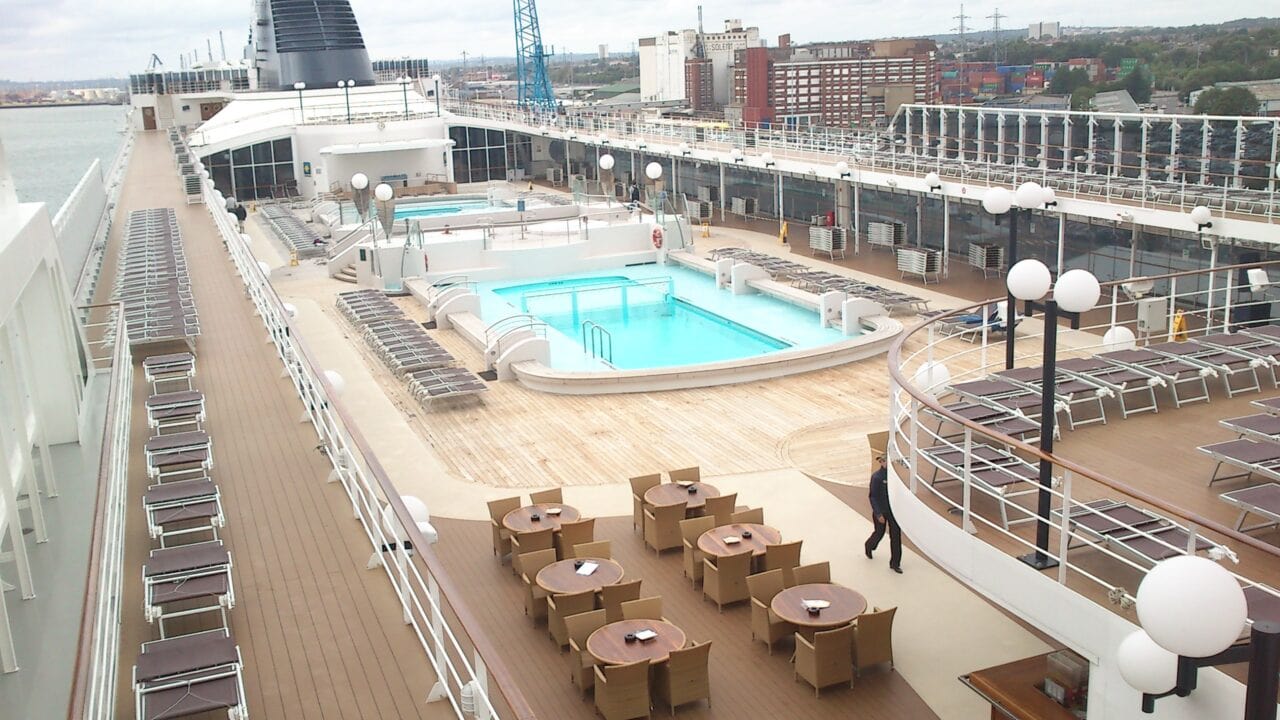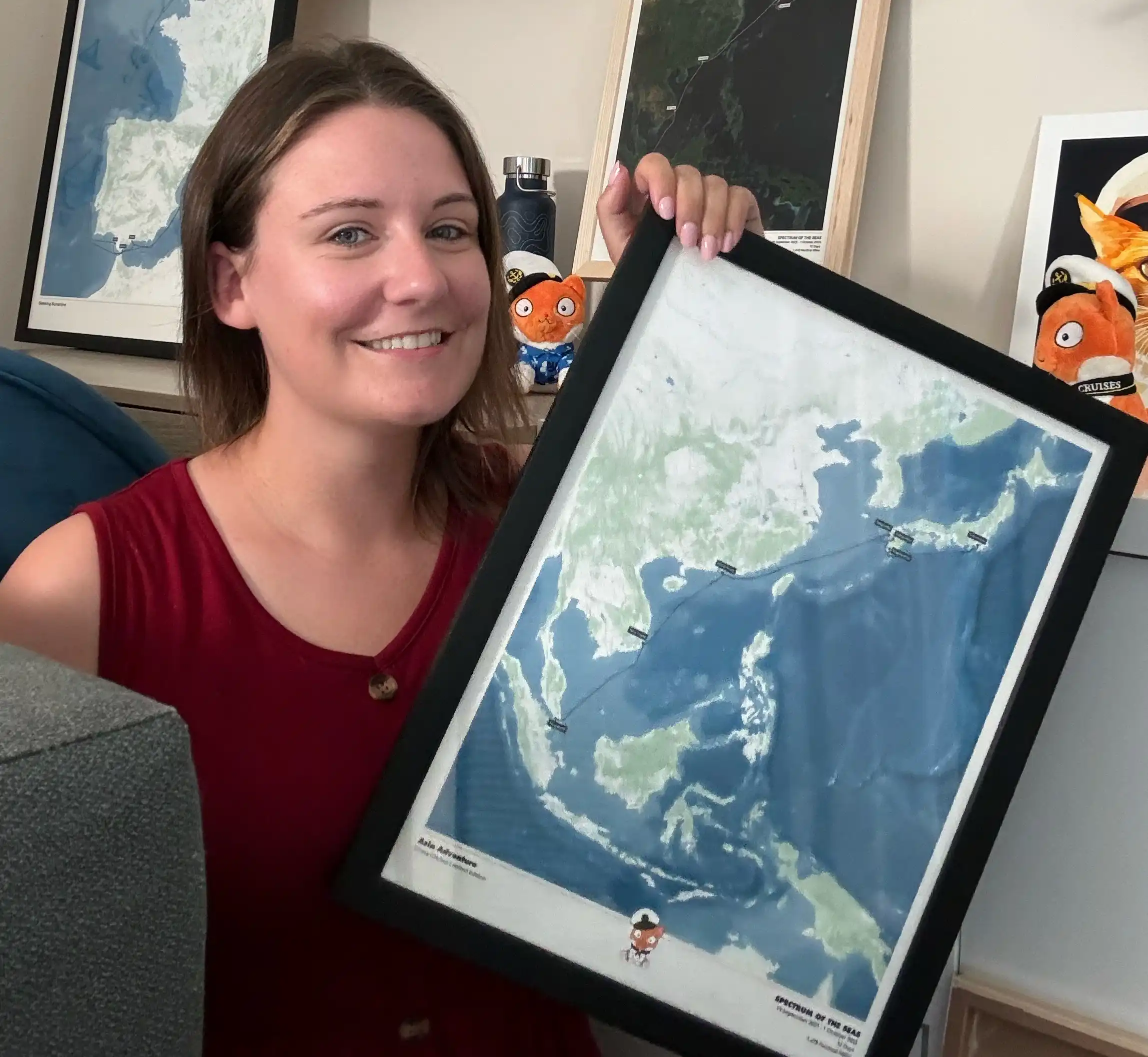It may be hard to believe, but cruiselines sometimes cut their ships in half, and add a new section into the middle.
This makes the ships longer, allows for more passengers onboard, and takes a fraction of the time of building a new ship.
Many major cruise lines l- Norwegian, Royal Caribbean, MSC – have lengthened their ships – although with the introduction of newer and bigger ships to their fleets, this is now happening less often.
The older, smaller ships are now coming to the end of their life span, and being withdrawn from service rather than being “stretched.”
There are lots of reasons that “stretching” – or “lengthening” – cruise ships makes good financial sense for cruise companies.

Why Would Cruise Lines Want To Stretch Their Ships?
- Stretching a cruise ship can add a substantial amount of extra capacity comparatively quickly.
- This is far cheaper than commissioning a newly built ship.
- Savings can be made due to “Economies of Scale”
- If you can get more passengers on one ship, you need less crew and resources to cater for them.
- If you had two smaller ships, you would need two Captains, Two Chief Engineers, Two Cruise Directors etc – if you can fit all those passengers into one, larger ship and employ less staff – the savings are massive.
- If you have one large ship instead of two smaller ones, you save on port fees and taxes.
- A good time for ship upgrades
- If a ship requires some refurbishment, this is a perfect time to carry that out.
- When Royal Caribbean’s Enchantment of the Seas was upgraded, as well as adding 150 new cabins, and giving the ship a general refurbishment – they added a water park too!
- It Lengthens the life span of the ship
- By lengthening the ship and upgrading it, the ship will be able to continue sailing for the cruise line for longer.
- It will be able to compete more easily with newer ships in the fleet because of its improved facilities.
How Is The Process Carried Out?
- The Cruise ship is sliced down the middle
- The Forward and the Aft sections of the ship are moved apart
- A new section is added into the middle, which contains cabins, public spaces and will create extra top deck space
- The new section is welded in place – which is easier said than done! Winches and ballast tanks may have to be used to align the three separate pieces perfectly before welding can begin.
- After all three sections have been completely united, strong longitudinal steel strapping is welded along both flanks and to either side of the keel, binding the thirds together forever.
- Electrical systems in the new part have to be integrated into the ship’s existing systems.
- Internal fixtures and fittings are added, making the new section blend seamlessly with the older parts of the ship.
Watch this being done in the short video below:
History Of Cruise Ship “Stretching”
In 1977, Royal Caribbean’s “Song of Norway” was the first modern cruise ship to be cut in half and lengthened.
She returned to the Finnish Shipyard, Wärtsilä where she was originally built in 1969.
She had a new midsection added into the middle of her hull. This increased the overall length from 550 to 635 feet, while increasing passenger capacity by 328.
The stretching wasn’t straightforward, with the yard having to use ballast tanks and winches to align the new section with the stern and aft sections of the ship – but the work was completed in less than three months.
In November 1977 Song of Norway had completed her sea trials and been handed back to Royal Caribbean.
Following a brief stop in Rotterdam for a press tour, she began her crossing back to Miami.
It was found that the longer ship negotiated the Atlantic waves well, and the fuel consumption had only increased marginally.
Song of Norway resumed her normal cruising schedule in December 1977, having been out of service for slightly less than four months.
She sailed out of Miami, with an increased passenger capacity of a remarkable 44%.
The estimated cost for the work at the time was around $12 million – only $1.5 million less than the ship cost to build eight years earlier.
The financial success of increasing the passenger capacity was noted by other cruise lines, and they were soon considering the same thing…
Examples of Other Ships That Have Been Lengthened
MSC Lirica Class ships – Lirica, Armonia, Sinfonia and Opera
MSC Cruises lengthened all four of its Lirica-class ships – MSC Lirica, MSC Armonia, MSC Sinfonia and MSC Opera – between 2014 and 2015.
The work was carried out by the Italian shipbuilder Fincantieri over a two-year period..
The four Lirica-class ships were originally built between 2003 and 2005 at the STX yards in Saint-Nazaire, France.

An 80-foot-long section was added to the middle of each ship.
This added nearly 200 more cabins, extended the shops onboard, added a spray water park for children onboard – and they also took the opportunity to refit restaurants and public areas.
The work was carried out to help the ships compete with bigger vessels from other cruiselines sailing in the Mediterranean waters.

Silversea – Silver Spirit
The Italian Shipyard Fincantieri stretched the 36,000-ton Silver Spirit in 2017.
The refit, which also included a general shipwide modernisation, added the features that Silversea’s then most recent vessel, the Silver Muse, also featured.
The Silver Spirit was fitted with a new fifty-foot section. This added 34 new suites and increased the size of several areas of the ship, including the pool deck.
Windstar Cruises – Star Breeze, Star Pride and Star Legend
Windstar Cruises stretched its three Star-Class vessels.
Called the “Star Plus Initiative” the $250-million project started with the Star Breeze in 2019.

Again, this work was carried out by the Italian Fincantieri shipyard in Palermo.
Once the work was completed the three vessels were 80 feet longer, with 50 new suites, and two new restaurants.
All the ship’s bathrooms were replaced. The ships also got four new engines and refurbished public areas.
Fred Olsen Cruiseline – Balmoral
Balmoral was a ship built in 1988 for Royal Cruise Line, who then sold out to Norwegian Cruise Line.
She sailed under the names Crown Odyssey and Norwegian Crown prior to her being sold to Fred Olsen.
The ship had the insertion of a new 98 ft midsection. The work was completed at the end of 2007, before she sailed her inaugural cruise to Florida in February 2008.
The lengthening added 186 passenger and 53 crew cabins – as well as creating new and updated public areas.

Norwegian Cruise Line – Pride of America
Pride of America was actually lengthened before she even set sail for Norwegian Cruise Line!
Construction of the ship began in 2000 in the USA as part of a plan for a US-built and US-flagged cruise ship under “Project America.” The project failed and she was then bought by Norwegian Cruise Lines and completed at the Lloyd Werft Shipyard in Bremerhaven, Germany.
She was inaugurated in 2005, and was the first new U.S. flagged cruise ship in nearly fifty years.
In August 2002 when Norwegian Cruise Line first acquired the 40% completed hull, they decided to lengthen her.
The ship was lengthened from 850 feet to 920 feet and the gross tonnage was increased from 72,000 to more than 80,000. She holds just over 2000 passengers.

The Impact And Future Of Cruise Ship Stretching
Stretching allows cruise lines to update their fleet and allow their older ships to remain competitive and cost-effective in a market where larger and larger ships are becoming the norm.
As time goes by, their smaller ships come to the end of their lifespan and are sold on or scrapped.
Cruise ship lengthening is therefore becoming more uncommon, as there are now fewer smaller ships sailing – partly due to the effect of the Covid pandemic on the industry.
Older ships don’t have enough lifespan left in them to justify spending millions of dollars to make them larger and more competitive.
Before You Go
Find out why you shouldn’t discount older, smaller cruise ships in the article below:
9 Reasons You Shouldn’t Avoid Cruising on Older, Smaller Cruise Ships
Find out about the 29 weirdest things we have seen people do on cruise ships here:
The Weirdest Things We’ve Ever Seen Guests Do On A Cruise – 29 Examples

Free Insiders Cruise Line Guide
Ever wondered how the mainstream cruise lines compare? Cruise lines won’t tell you this, but I will.
This FREE guide shows you everything you need to know to find your perfect cruise line.
Whenever I take a cruise I order a print of my trip. It uses the real satellite data from the cruise and is always a great conversation starter!
I'm building an impressive collection...
Code EMMACRUISES will get you 10% off

